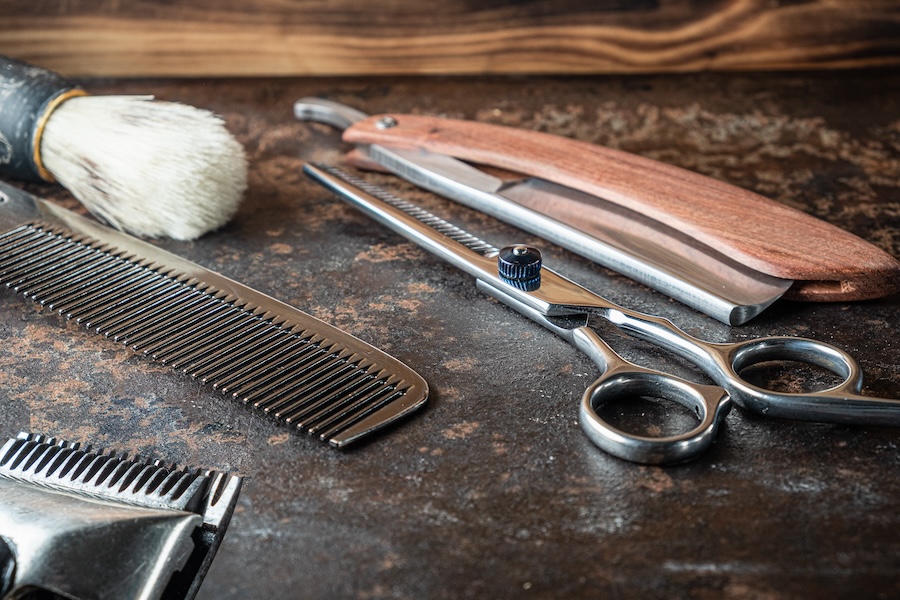History of Shaving | Tools, Customs, and Beliefs

 Joe Nightingale, MBBS, MSc
Joe Nightingale, MBBS, MSc

Shaving has never been so easy. Thanks to electric shavers, disposable razors, and inexpensive cartridges, shaving is an everyday occurrence – something you give no more mind to than brushing your teeth or washing your hair. We’ve even got scented beard oils and creams to nourish the hair and special brushes to keep it groomed.
The history of shaving tools, however, is a lot more complicated. Our ancient ancestors didn’t have access to the advanced tools we have today. Some might get the impression that in the earliest days, cavemen and hunter-gatherers forewent shaving entirely. Not so. For millennia we’ve been preening and pruning ourselves. The question is how did we do it?
In this article, you’ll find:
- Shaving in Prehistory
- Shaving in Antiquity
- Renaissance Innovations
- Invention of the Safety Razor
Shaving in Prehistory
Precisely when humans started shaving is unclear. Archaeologists and anthropologists date the practice to approximately 100,000 BC. Back then, we didn’t have razors; in fact, we didn’t really shave at all. Removing body hair was a painstaking process of pulling the hairs out one by one – using rocks or shells to do so.
According to cave paintings, humans held two seashells together to form the tweezers. Why did they do this? Well, it wasn’t just fashion; less hair meant less lice, and it kept you cooler in hot climates.
It took another 30,000 years before early man recognized the value of a sharpened flint. Flint forms razor sharp edges – still among the sharpest tools today – that delicately slice any hair from your body. Other tools included obsidian, sharped shark teeth, and sharpened clam shells. We might have been primitive, but there’s no denying the ingenuity.
Shaving in Antiquity

The dawn of civilization saw new innovations in the history of shaving tools. Ancient Egypt was the first to embrace shaving – it was considered critical for good hygiene. (In fact, any beards you saw at the time were usually wigs.)
Entering into the copper and bronze ages, new metal razors with a circular or hatch-shaped rotary blade became more common. Examples were found in Egyptian burial chambers dating to 3,000 BC. The Egyptians were also the first to innovate a depilatory cream for women. Made from arsenic, quicklime, and starch, it dissolved hair at the skin level, achieving skin as smooth as silk.
In ancient Greece, beards were seen as a rite of passage – most men of the time prided themselves on a full beard. Cutting a man’s beard against his will was a violation, intended to shame a man after battle. Alexander the Great, as with everything else, changed this tradition forever. He told soldiers to shave the beard as it was a liability in battle.
The Romans, on the other hand, always disliked the beard. According to tradition, the first few facial hairs a boy receives would be offered to the gods for good health and fortune. Beards were largely seen as barbaric – something worn by the uncivilized Gauls and Germans. Julius Caesar famously plucked his beard hairs. It wasn’t until Emperor Hadrian – a fanatical Hellenophile – that the beard returned.
Renaissance Innovations

Flash forward roughly 1,500 years and the history of shaving tools was ready for its next installment. Throughout the Enlightenment and Early Modern Era (~15th to 18th century), new steel-edged razors became popular. With better tools, shaving was a cultural norm, and barber shops began to spring up all over Europe.
Strangely, your local barber was also a surgeon – known originally as a barber-surgeon. Common in medieval Europe, they were often the first point of contact for the sick and injured. Why? Well, as the profession most skilled with a blade, they could also perform minor surgeries, bloodletting, leeching, and even amputations, in addition to their grooming services.
Indeed, the symbol of the red and white barber pole is a relic of this era. The red stripes represent blood, while the white stripes symbolize bandages.
Invention of the Safety Razor

Sheffield, famed for its steel production, manufactured steel-edged cut-throat razors from 1680 onwards. Compared to the previous medieval razors – which looked like small axes – it was a major step upwards. The Perret razor, with its wood guard, came in the late 1700s: a stepping stone towards the safety razor.
The first official “safety razor” was developed by William S. Henson in 1847. Composed of a double-edged safety blade with a “hoe” shape, it reduced the need for skill in order to get a close shave. Barber shops, specializing in shaving, suddenly began to disappear.
Almost fifty years later, a certain King Gillette – a traveling salesman – invented disposable razor blades in 1895. Working with MIT professor William Nickerson, the pair developed a safety razor compatible with replaceable blades. So, if your blade began to dull or rust, you could now swap it out for another.
The problem? Early replaceable blades would rust after a single use or two. However, metallurgic advancements meant that by the 1960s, blades were made with stainless steel allowing for multiple uses.
Try Beard Sorcery Grooming Tools

That’s the history of shaving tools! From flint shards to disposable razors, it’s been a long journey. But modern appliances and tools make it easier than ever to keep your facial hair in check. Of course, if you’re a beard connoisseur, you don’t want to shave it off, only keep your beard groomed and maintained.
Enter Beard Sorcery – our magical selection of beard tools and products are perfect for all kinds of beards. Trust our mustache trim scissors or boar’s hair beard brush to help as you trim and shape your beard hair. Meanwhile, our collection of beard oils, balms, creams, and more work wonders in nourishing and softening the hair.
Interested? Browse our selection to find the right tools and products for your facial hair.

No comments yet…